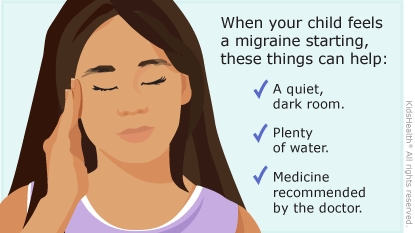A migraine is a type of headache (pain in the head) that recurs (keeps coming back). During a migraine, someone may also have nausea (feeling sick to the stomach), vomiting, or dizziness, or be bothered by light, sounds, or smells.
Certain things can trigger (set off) a migraine, such as stress, bright light, hormonal changes (in females), not getting enough sleep, and skipping meals. For some people, certain foods/drinks also can bring on a migraine.
Treatment for migraines includes avoiding or managing triggers. Health care providers can also prescribe medicines to help a migraine go away or to make them happen less often.
Your child was treated in the hospital and is now ready to go home. Follow these instructions to care for your child.


Follow your health care provider's instructions for:
Care for your child when they have a migraine. As soon as your child begins to feel migraine symptoms:
Help your child find what triggers their migraines. Have your child keep a migraine diary that includes:
To help prevent migraines, encourage your child to:

Your child:

Your child has a migraine and:

What causes migraines? The exact cause of migraines isn't known. Doctors and scientists think that they happen because some neurons (nerves in the brain) stop working properly and send the wrong signals. This may affect the nerve system that regulates pain.
Migraines can run in families. Kids and teens with migraines often have family members who get migraines.
What is an aura? An aura is a symptom that starts right before a migraine comes. There are different kinds of auras, such as having blurry vision, seeing flashing lights, or noticing blind spots. Not everyone with migraines has auras.
What foods and drinks can cause migraines? Common food triggers include high-caffeine energy drinks, certain cheeses, aspartame (an artificial sweetener), chocolate, lunch meats, hot dogs, MSG (a food additive), and alcohol.